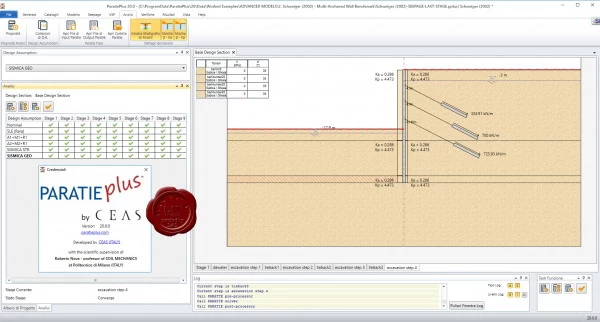Ce.A.S. s.r.l. ParatiePlus v20.0.0 repack
In Italy as well as in many Countries worldwide, several designers rely on Paratie Plus in their retaining wall projects.
For example, in the construction of the High Speed Trains guyed bridge over Po River near Piacenza, several cofferdams and other waterfront structures had been designed by our engineers using past versions of Paratie Plus. More recently, thank to the same design tool, other Italian engineering firms, have designed the temporary cofferdams for all river crossings along the new high speed train line linking Milano to Brescia. Stemming from a cooperation, since 1985, with professor Roberto Nova from Politecnico di Milano, Paratie Plus is a non linear analysis program conceived to model the soil-structure interaction of a flexible retaining wall, by means of the popular subgrade reaction method, a simple yet widely accepted approach in current design practice as well as by most of design standard worldwide, including Eurocodes.

Thanks to its effectiveness, Paratie Plus is a simple yet accurate retaining wall design tool. In most cases, a Paratie Plus analysis can be sufficient to completely define a wall design. However, even in very complex situations, Paratie Plus may provide valuable design information, at least in the preliminary design stages: if required, selected final layout will be more thoroughly analyzed, with more advance but complex programs such as FLAC.
Since 2009, Paratie Plus evolved towards an integrated design environment, which offers several additional analysis options, including slope stability analysis and 2D seepage analysis. Some of the most relevant Paratie Plus features, which are hardly found in competitor tools on the market, are listed here:
In Italy as well as in many Countries worldwide, several designers rely on Paratie Plus in their retaining wall projects.
For example, in the construction of the High Speed Trains guyed bridge over Po River near Piacenza, several cofferdams and other waterfront structures had been designed by our engineers using past versions of Paratie Plus. More recently, thank to the same design tool, other Italian engineering firms, have designed the temporary cofferdams for all river crossings along the new high speed train line linking Milano to Brescia. Stemming from a cooperation, since 1985, with professor Roberto Nova from Politecnico di Milano, Paratie Plus is a non linear analysis program conceived to model the soil-structure interaction of a flexible retaining wall, by means of the popular subgrade reaction method, a simple yet widely accepted approach in current design practice as well as by most of design standard worldwide, including Eurocodes.

Thanks to its effectiveness, Paratie Plus is a simple yet accurate retaining wall design tool. In most cases, a Paratie Plus analysis can be sufficient to completely define a wall design. However, even in very complex situations, Paratie Plus may provide valuable design information, at least in the preliminary design stages: if required, selected final layout will be more thoroughly analyzed, with more advance but complex programs such as FLAC.
Since 2009, Paratie Plus evolved towards an integrated design environment, which offers several additional analysis options, including slope stability analysis and 2D seepage analysis. Some of the most relevant Paratie Plus features, which are hardly found in competitor tools on the market, are listed here:
Code:
- a rigorous soil model formulation within modern Soil Mechanics framework;
- a special constitutive model for clays in both drained and undrained conditions, based on critical state concepts;
- a realistic construction stage modelling, even for quite complex sequences;
- a general seepage scheme for layered soils;
- external loadings and interaction with nearby foundations modelling;
- in any construction stage, support and loading layout can be modified arbitrarily ( special non linear supports, prestressed ground anchors, struts, slabs and other features are allowed);
- two facing walls can be modelled thus allowing a coupled analysis of a sheetpile and its anchoring wall;
- a pseudo-static seismic procedure is included, based on a well documented proprietary algorithm;
- a GUI interface including, among many other features, a complete set of online correlations to assist the Users in selecting appropriate soil parameters based on most common in situ or lab tests;
- a linkage with the modern Limit Stated design methods, according to Eurocodes 7 and 8 as well as to NTC, EC2 , EC3 , AISC and ACI, for structural checks.